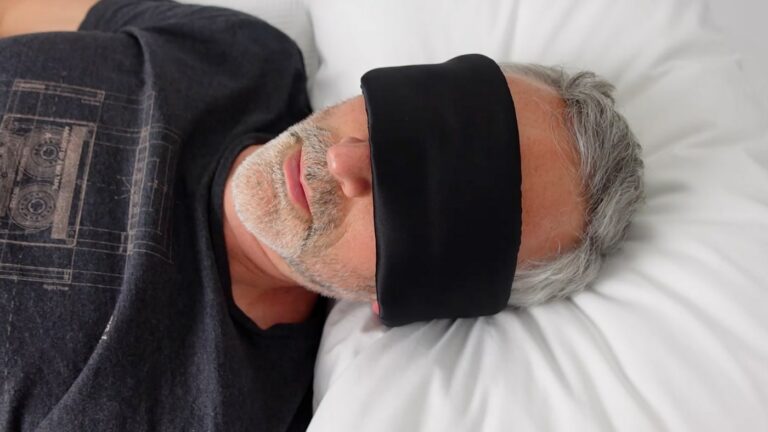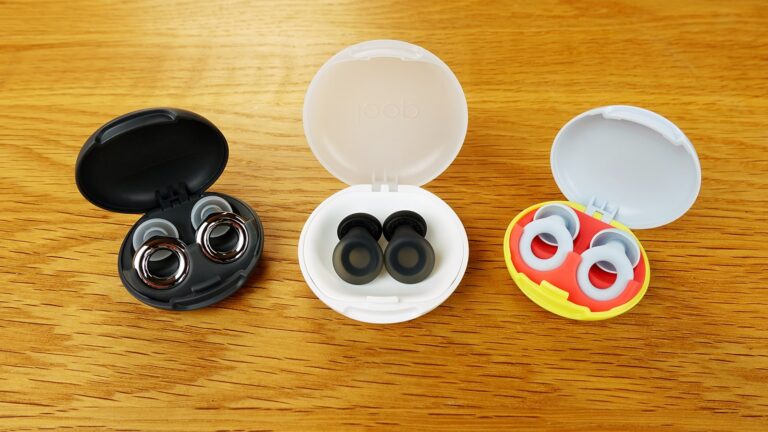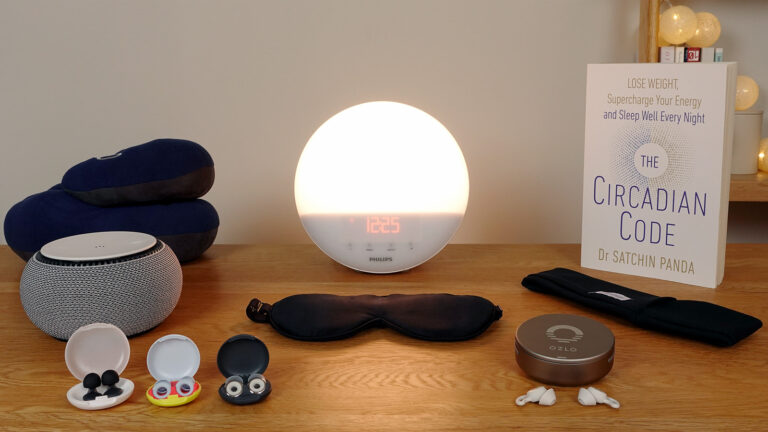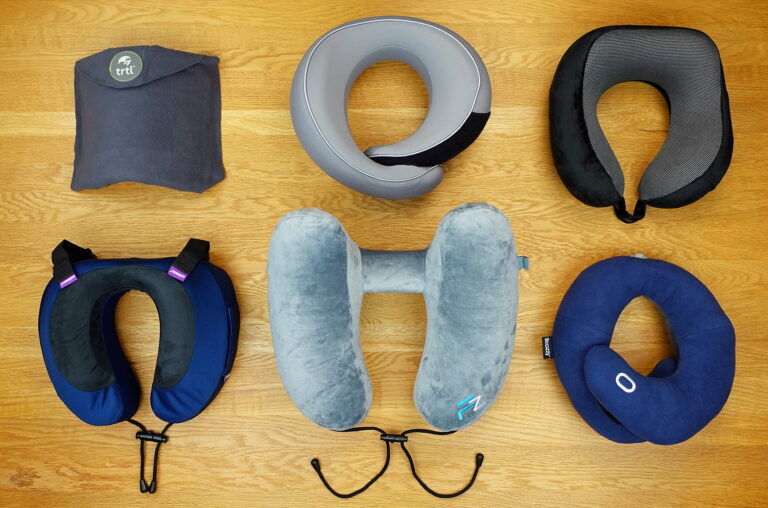Disclosure: My website is reader supported. If you choose to buy a product after clicking a link, I may earn a commission, at no extra cost to you. Learn more.
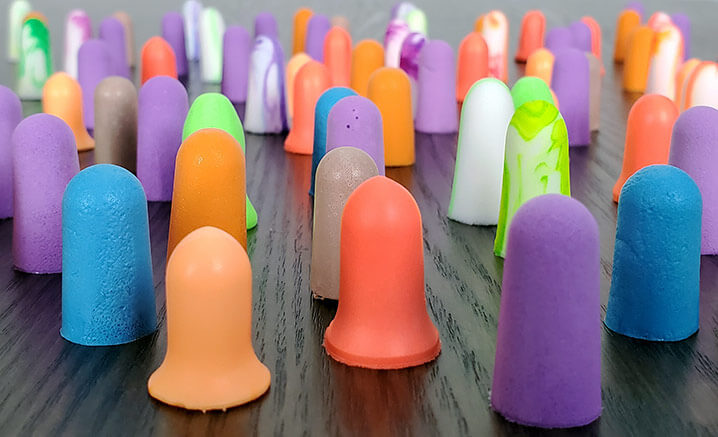
In the photo above, you can see some of the foam earplugs I’ll be discussing in this article. Although I’ll look at wax and silicone too, foam earplugs are usually better for blocking out loud noise while you’re sleeping because of their higher noise reduction rating.
If you’re anything like me, even the sound of a dripping tap can be enough to keep you awake. Being such a light sleeper, I’ve spent years trying out various earplugs to block out the noise of a snoring partner or the traffic outside.
To save you from the same trial and error, I’ve put together a comprehensive comparison of 15 different earplugs that I’ve personally used for sleep. I’ve tested each of them for a minimum of 10 nights, and some for much longer because they are the earplugs I regularly use.
In this article, I’ll share my experiences with each earplug to help you find the best one for your needs. To make it easy for you to navigate, I’ve divided the article into several sections:
Contents
- Overview of the earplugs
- Comparison table
- My video review
- Transcript part 1: the earplugs I use
- Transcript part 2: tips for using earplugs
- Transcript part 3: the earplugs in detail
Overview of the earplugs
Mack’s Ultra Soft
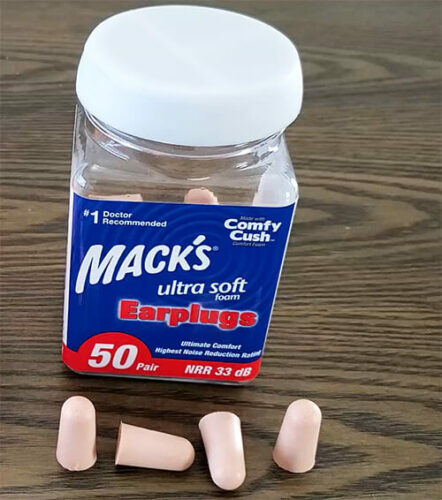
Price: $
Mack’s Ultra Soft earplugs are my personal favorite when I’m not testing other options. With a noise reduction rating of 33 dB, they offer the highest level of protection during the day and the best noise reduction while sleeping. They are ideal for people with small or medium-sized ear canals, and their soft foam makes them very comfortable to wear in bed, even when sleeping on your side. Like most foam earplugs, they are disposable but relatively inexpensive, so they are a great option for nightly use.
The Ear Buddy
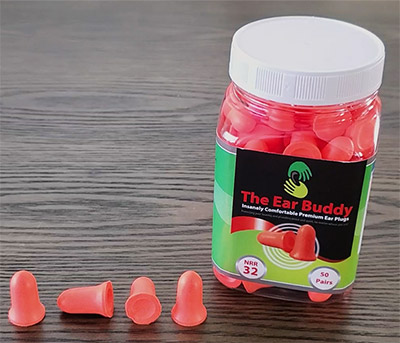
Price: $
The Ear Buddy earplugs are a great option for people with medium or larger ears. With a noise reduction rating of 32 dB, they effectively block out a lot of noise, and the comfortable foam makes them suitable for wearing in bed. The unique bell shape and winged tip make them easy to remove, which is especially helpful if you have deeper ear canals.
Hearoes Xtreme Protection
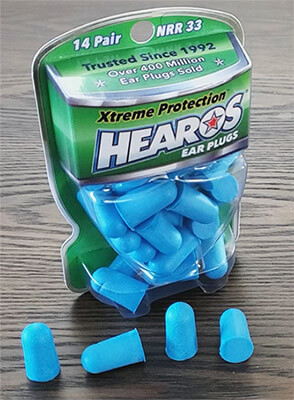
Price: $
Hearoes Xtreme Protection earplugs have an impressive noise reduction rating of 33 dB, making them highly effective at blocking out sound. They are larger in diameter and may be more suitable for people with larger or medium-sized ears. They are available in some pharmacies and supermarkets in the US, so you can see them in person before making a purchase online. The foam is quite dense since they were not designed specifically for sleep, but I still find them comfortable enough to use in bed.
Hearoes Ultimate Softness
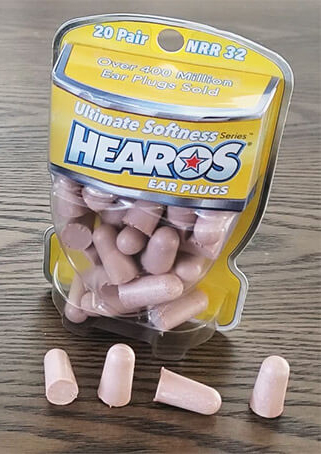
Price: $
Heroes Ultimate Softness have a slightly lower noise reduction rating than Xtreme Protection (mentioned above), but still provide a high level of protection at 32 dB. They are also considerably softer, which makes them a good choice for sleeping. They have a similar shape, size, feel, and color to Mack’s Ultra Soft, so they are a great option for people with small to medium-sized ears.
3M 1100
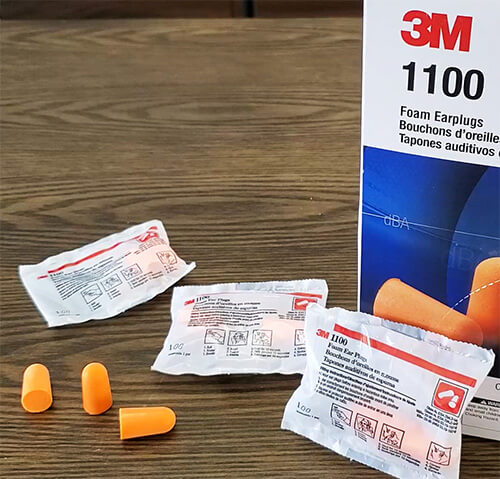
Price: $
While the 3M 1100 earplugs are technically intended for industrial work, I’ve included them here because of their superb noise blocking. Despite having a rating of only 29 dB, I find they are very effective. They are more suitable for people with medium to large-sized ears, rather than smaller ears. Although they are not designed for regular nightly use and have dense foam, they are a great option for occasional use when you need solid noise reduction. The fact that pairs come in individually wrapped bags makes them hygienic for travel or sharing.
Howard Leight Laser Lite
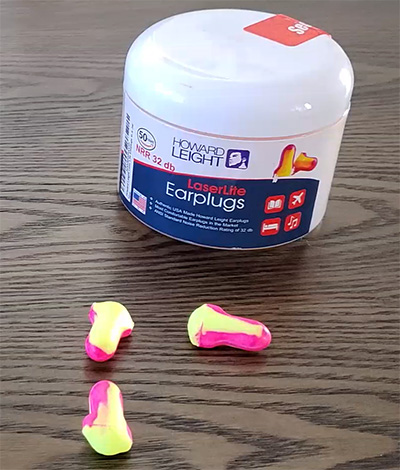
Price: $
The Howard Leight Laser Lite earplugs have a noise reduction rating of 32 dB, making them highly effective at blocking out noise. They are larger in size and are best suited for people with medium to large-sized ears. The unique winged tip design makes them easy to grip and remove, which is more practical if you have deep ear canals or finger sensitivity issues. The foam feels quite soft despite their large size, so they are worth trying in bed if you have larger ears.
Howard Leight Max Lite
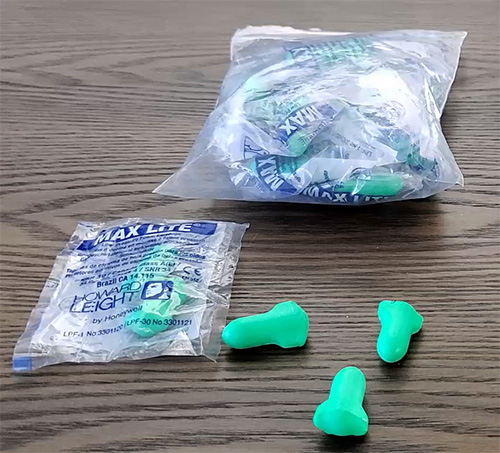
Price: $
The Howard Leight Max Lite earplugs have a similar shape to the Laser Lite, making them easy to remove in the morning. However, they are slightly smaller and may be better suited for people with medium-sized ear canals. Although their noise reduction rating is lower at 30 dB, I still find them effective at blocking out noise. These earplugs come in individually wrapped bags, which is more hygienic than the Laser Lite and makes them a great option for sharing with others.
Moldex Soft Foam

Price: $
Moldex Soft Foam earplugs are known for their high noise reduction rating of 33 dB, making them an excellent choice for blocking sound. They are longer than most foam earplugs, which makes them a suitable option for people with deeper ear canals. However, they may not be the best option for those with smaller ears since they have a wider diameter. The soft foam material makes them comfortable to use while sleeping, and they are also effective for reducing the sound of work-related noise.
Moldex Spark Plugs
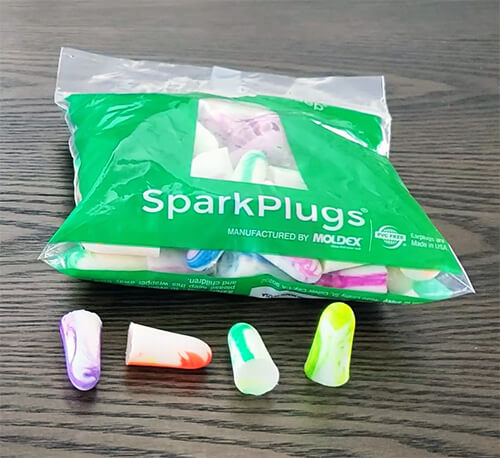
Price: $
Moldex Spark Plugs are similar to the Moldex Soft Foam earplugs in that they are longer than standard foam earplugs, making them better suited for people with medium to large-sized ears, especially those with deeper ear canals. With a noise reduction rating of 33 dB, there isn’t much difference between the two styles, except perhaps for the glaringly obvious bright colors that the Spark Plugs come in!
Flents Quiet Time
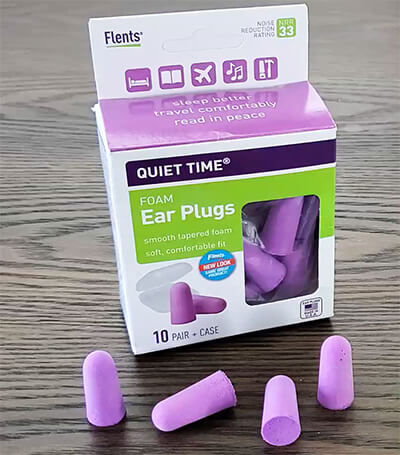
Price: $
Flents Quiet Time earplugs are manufactured by Moldex and distributed by Flents. This explains why they are similar in design and noise reduction rating (33 dB) to the Moldex Soft Foam earplugs. However, the Quiet Time earplugs are available in smaller packs, so you don’t have to buy a large quantity at once. Like the Soft Foam earplugs, they are best suited for people with medium-sized ears who can tolerate longer earplugs while sleeping.
Flents Quiet Contour
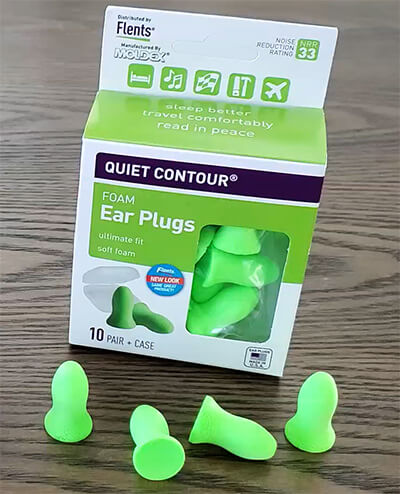
Price: $
Flents Quiet Contour earplugs have a unique shape with a bell curve and winged tip in one, which makes them easy to remove. This design may work well for some people. However, they have a wider diameter, so they are only suitable for people with larger ear canals. With a noise reduction rating of 33 dB, they are a good option for blocking out loud, intrusive sounds at night.
Quies
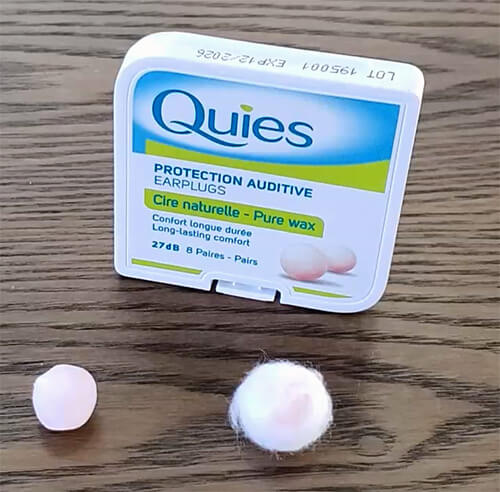
Price: $
Quies wax earplugs may be the best alternative if you don’t like the feel of foam expanding in your ear. Ideally, they should only cover the ear canal opening instead of going deep inside, and they will fit all ear sizes. The noise reduction rating is only 27 dB, though. While this rating may be sufficient for blocking out quieter sounds at night, they may be less effective at blocking out loud snoring, for example. However, what they lack in noise reduction, they make up for in comfort.
Mack’s Pillow soft
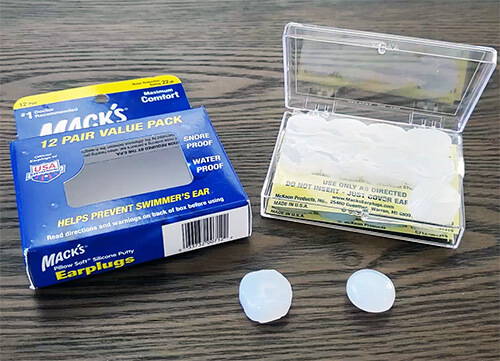
Price: $
Mack’s Pillow Soft earplugs are another alternative to foam earplugs, made of silicone rather than wax like the Quies earplugs. They are also appropriate for all ear sizes. They mold to the shape of your ear canal entrance rather than being inserted deep inside, making them comfortable to wear while sleeping. However, the noise reduction rating is the lowest of all the earplugs I’ve tested, at just 22 dB. So while they will help with quieter sounds, they may not be sufficient if you have loud snoring or other noise to contend with.
Comparison table
In the table below, you can compare the material, size, and noise reduction rating of the earplugs. Note how the noise reduction rating of the foam earplugs is higher than the wax or silicone. This is usually the case, and I’m yet to find silicone or wax earplugs with a noise reduction rating higher than 30.
As for the sizes, this is how I personally describe them relative to each other. I had the opportunity to line them all up and divide them into three groups: small, medium, and large.
This is my opinion though, and you may find that one I describe as medium may fit you fine even if you feel that your ears are smaller or larger! It’s not a very exact science, and I don’t know of any other source that attempts to scientifically categorize them based on their size relative to people’s ear canal sizes. Having said that, if you are a petite person with small ears, I would probably avoid the ones I describe as large.
| Earplug | Material | Size | Noise Reduction Rating (decibels) |
|---|---|---|---|
| Mack’s Ultra Soft | Foam | Small Medium | 33 dB |
| Ear Buddy | Foam | Medium Large | 32 dB |
| Hearoes Xtreme Protection | Foam | Large | 33 dB |
| Hearoes Ultimate Softness | Foam | Small | 32 dB |
| 3M 1100 | Foam | Medium Large | 29 dB |
| Howard Leight Laser Lite | Foam | Large | 32 dB |
| Howard Leight Max Lite | Foam | Medium | 30 dB |
| Moldex Soft Foam | Foam | Medium Large | 33 dB |
| Moldex Spark Plugs | Foam | Medium Large | 33 dB |
| Flents Quiet Time | Foam | Medium | 33 dB |
| Flents Quiet Contour | Foam | Large | 33 dB |
| Quies | Wax | All sizes | 27 dB |
| Mack’s Pillow Soft | Silicone | All sizes | 22 dB |
Video review
In the video below, I discuss the earplugs in this article and demonstrate how they look and feel close up. I also compare some of them side by side to help you understand the different sizes and shapes. I filmed it in 2021, but most of the earplugs are still available and my thoughts on how effective they are remain the same.
Two of the earplugs in the video – the Howard Laser Leight small and the Brison – are not available at the time of my latest update (20 April, 2023). I don’t know when they will be back in stock.
Video transcript part 1: the earplugs I use
I’ve edited the video transcript to make it flow better and easier to scan. All the information in the video is also in this written version though.
Introduction
Hi, I’m Ethan Green from nosleeplesnights.com. In this review, I’m going to be talking about earplugs, based on my own experience of using them off and on to help me sleep for the last 20 years.
I’m not going to try and rank them in order of best to worse though, because I think this is one area where it’s kind of impossible, and kind of pointless, to say that this specific earplug is the best there is on the market and that it will be fantastic for everybody. And that’s for one key reason: your personal ear canal size makes a big difference to how effective an earplug is going to be or not.
I know perhaps not everyone wants to watch a long video (or read a long article) about earplugs just to find out which ones might be good for them or not. So before we start talking about my overall view on earplugs, and making some recommendations, I’m going to tell you exactly which ones I use out of these, and which ones I recommend for people who have perhaps smaller or larger ears than me.
The earplugs I use at the moment
The ones I’m currently using myself for sleep are the Mack’s Ultra Soft (See on Amazon).

They have the right balance between noise reduction and comfort. Officially, it says on the pot ‘noise reduction rating of 33 dB (decibels)’, which is the maximum that you’ll find with foam earplugs.
The most important point for me is that they feel comfortable. And even though I have a suspicion that these are perhaps a tiny bit too small for my ears because there are a couple of larger ones that actually block out more sound for me, the fact is that they have the right balance between comfort and sound blocking.
So I’m quite happy to have a little bit less sound blocking if it means that I can use them as a side sleeper night after night, which is what they allow me to do.
Quick picks for smaller ear canals
If you have small ears, small ear canals, then I think that the Mack’s Ultra Soft (see above) are a good option because they’re on the smaller end of the earplugs size spectrum. But there are some other small ones that I would also recommend for people who have an issue wearing foam earplugs because they feel too large.
For me, the Howard Leight small earplugs (currently unavailable!) are a good option out of this particular selection. They say small earplugs and they are small earplugs. So for foam earplugs, those are ones to try too.
In the photo below, you can see my top two recommendations for people who prefer small earplugs:
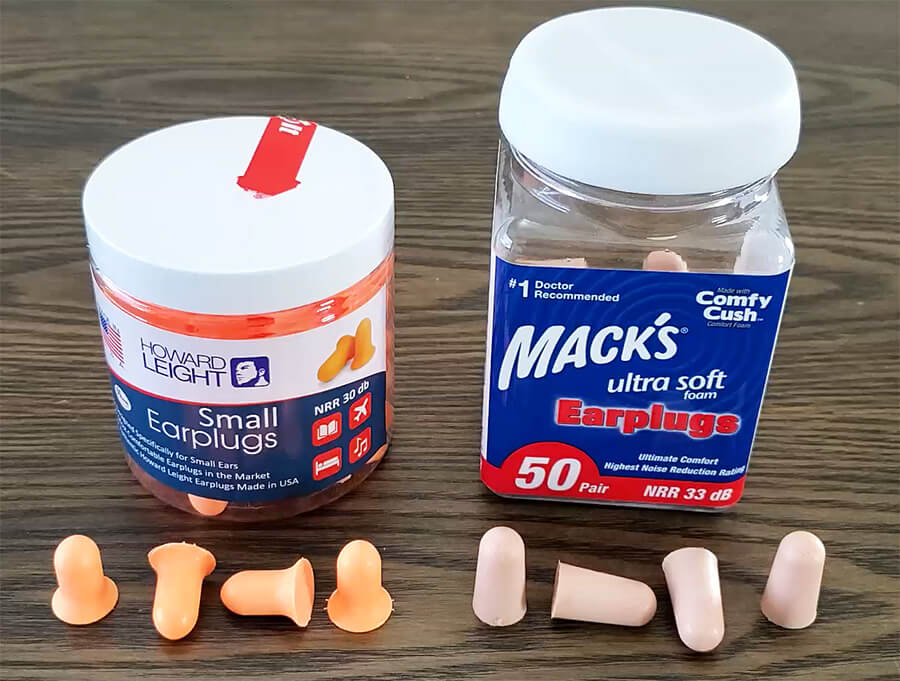
Note: how do you know your ear canal size? One easy rule of thumb to start with is that women tend to have smaller ear canals than men, though there are exceptions.
The best way to find out for sure is to ask an audiologist or your doctor to tell you their opinion. Companies that do custom molded earplugs can also take an impression and tell you. If you don’t want to pay that expense, I would try to guess based on your ear and/or body size. Alternatively, try a medium size first and then go smaller or larger if necessary.
Quick picks for larger ear canals
If you have larger ear canals then there are a couple I’d recommend trying first of all if you’re going to do some trial and error. One is the Hearoes Extreme Protection (see on Amazon).

These are really good in terms of their noise reduction rating (33 dB), the average noise reduction rating that you might expect from them. And they’re quite large compared to most foam earplugs, so they are good ones to try if you’ve got larger ears.
And another one that I think is particularly good for larger ear canals is the Ear Buddy (see on Amazon).
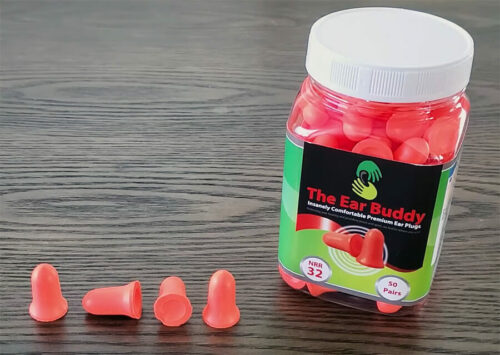
These are actually some that I like to have around the home as well for nights where there’s a bit more noise perhaps than my ambient normal noise, which at the moment isn’t too bad.
But if I’m staying away from home, for example, or my neighbors are being noisy, these ones are a bit larger, they fill my ears more, and they block out more sound. So I think these are good ones to test out if you’ve got larger ear canals.
Foam, wax, or silicone?
As for all the rest of them, there are a couple more points I think are really important to make. Not everyone likes foam earplugs for starters. Most of these are foam earplugs because at the end of the day there are a lot more brands, types, styles, and sizes of foam earplugs than there are other types.
If you’re not a fan of foam earplugs, or you’ve found them a little bit uncomfortable in the past because they fill your ears and expand in a way that you don’t like, then there are a couple of other options.
Firstly, you have the silicone earplugs like these here – the Mack’s Pillow Soft (see on Amazon).
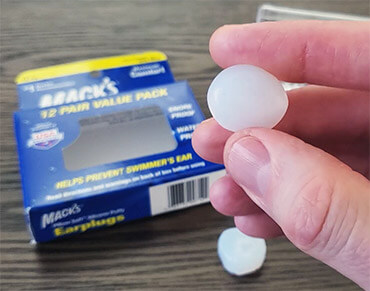
I’ve chosen these ones not because I’m a fanboy of Mack’s earplugs, but because they are the easiest to use of the different silicone ones that I’ve found.
I just find that they’re quite easy to mold and to shape, I like the way that they’re contained in the packet, and they’re a reasonable price.
Secondly, there’s the option of wax. The ones I recommend are the Quies (see on Amazon), which are good wax earplugs.
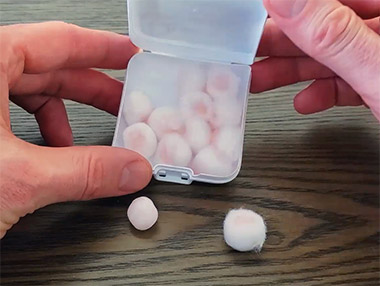
There are a couple of other brands as well that are decent, but these are the ones that I’ve had the most success with, and I like the hygienic packet that they’re kept in.
However, silicone and wax earplugs have a much lower noise reduction rating than foam earplugs typically do, especially good foam earplugs. So for me, they kind of tip the scales between being more comfortable because they don’t go deep inside your ear canal, but having less noise reduction.
So I think that’s an important point to bear in mind: if you’re not a big fan of foam earplugs then you’re probably going to have to accept less noise reduction.
And if you’re sleeping next to a snorer who has severe snoring and they’re snoring at 50, 60, or more decibels and these earplugs only reduce 22 to 27 perhaps, then that’s going to be a lot of noise that gets through still.
Video transcript part 2: tips for using earplugs
Advice if you still hear noise through earplugs
What do you do if you’ve bought yourself some earplugs, or you’re on your second, third, or fourth trial of a different kind of earplug and you can still hear some noise?
I think there are a few key points to bear in mind if this happens.
The way you fit them matters
Firstly, the way you fit them matters, particularly with foam earplugs, but also with wax and silicone.
With foam earplugs, I think it’s really important that you fit them correctly. You can find videos online from some of the manufacturers on YouTube demonstrating how to fit them. Fortunately, it’s relatively simple once you know how.
Steps for inserting foam earplugs
- Roll it into the smallest cylinder you can.
- It’s good if you can reach over your head with your opposite hand, and pull your ear upwards and outwards.
- Insert the earplug.
- Hold it in place for up to 30 (or more) seconds. The pack might tell you how long exactly, as they expand at different speeds.
I think it’s good to keep them in place with your finger while waiting for them to expand. Otherwise, they can expand and edge out of the ear canal, or even fall out. I also think it helps to sit up in bed and insert them rather than trying to get them in when you’re lying down. I don’t know why, it just seems to work more effectively for me.
Is the noise louder than any earplug can block out?
Another thing to bear in mind is the fact that if you have tried them and you can still hear noise, it might just be that you’ve reached the limit of what earplugs can actually achieve in terms of noise reduction.
As I mentioned earlier, snoring can be very loud. Severe snoring could be 60 decibels or more. And when you consider the noise reduction rating of an earplug – the maximum here is 33 dB, which seems to be the ceiling for good foam earplugs – there’s a lot of noise that’s still going to get through.
So it’s often a case of lowering your expectations and trying to accept the fact that earplugs can reduce the noise hopefully to a tolerable level rather than giving you complete silence.
If you don’t have a roaring snorer next to you, and you’ve just got some ambient noise coming from outdoors, then perhaps it’s going to be easier to completely shut it out.
But at the end of the day, I think you may need to make a judgment call: how noisy is it in your bedroom? Is it worth spending more money experimenting on different types of earplugs in the hope that one’s going to magically completely cut it out? Because it might just be that they can’t.
Do some trial and error if you haven’t before
Even though I’ve talked about not wasting your money trying different earplugs, I do think it’s worth trying more than one type of earplug, and more than one size, to find the right one for you – especially if you haven’t tried many before.
If we were talking about something expensive, I wouldn’t recommend going and buying multiple versions of the same thing, because it probably would be a waste of money – especially if you couldn’t return them.
But earplugs can be pretty cheap, especially some of these that you can buy in smaller quantities online. I bought all of these online and the total price was quite a lot because there are so many of them, but if I was buying just two or three different ones it wouldn’t have been too expensive.
So I think it is worth getting a couple of different ones. Try and guess whether you think you’re going to be a small or a medium and just use a small and medium, or perhaps a medium and large and try those.
And try and get one that’s as close to 33 noise reduction rating as possible. Again, it depends on the fit and the size, but if it’s 30, 31, 32, 33, in my experience they tend to be pretty good. And definitely better than those that are somewhere between 20 and 27, 28, for example.
Okay, so those are all my recommendations about choosing earplugs in general. Now I’m going to go through each of them in turn, relatively briefly because I think this review is already going to be quite long. So I’m just going to make a couple of points about each one in case there’s any that you’re particularly interested in me covering.
Video transcript part 3: the earplugs in detail
Note on prices: the prices discussed are not live prices, but the prices when I bought them. Many products on Amazon change their prices regularly, so you might find a difference if you click any of the links to buy them.
Mack’s Ultra Soft + Howard Leight Small
Two foam earplug options for people with smaller ear canals

Okay, I thought I’d start off with two of my favorite smaller sized earplugs side by side.
Honestly, there’s no hard and fast rule, or measurement tool, that defines which ones are small, medium or large. These are just how I see it comparatively when I’ve lined them all up side by side and judged which ones I think are smaller, medium, or large.
As I already mentioned in the introduction, these two are both good small size earplugs to try. However, there are some differences. For example, the Mack’s Ultra Soft are a little bit longer and a tiny bit wider.
The Howard Leight Small have a winged end. That means they’re slightly easier to pull out in the morning, which I know some people, such as those with finger sensitivity issues, might prefer.
When it comes to the actual size of the pot, neither of them come in individually wrapped pairs. The Mack’s Ultra Soft come in a pot of 50 pairs, and the Howard Leight Small come in a tub of 60 pairs.
The prices were similar when I bought them. They were $9.89 for the Mack’s Ultra Soft and $9.99 for the Howard leight. That worked out at 20 cents per pair for the Mack’s Ultra Soft and 17 cents per pair for the Howard leight. I’m talking in cents because this is my US version of the earplug comparison; I bought all of these while I’ve been in the USA.
Another important point to mention is the noise reduction rating. The Mack’s Ultra Soft have a noise reduction rating of 33 dB. And the Howard Leight have a noise reduction rating of 30 dB. So according to lab tests, the Mack’s Ultra Soft should have a higher noise reduction rating. Again, it depends on the fit and what size ear canals you have, as I’ve already mentioned.
On balance, I think both of these are good earplugs to try if you’ve got smaller ear canals.
Mack’s Ultra Soft
- Material: foam
- Size: small
- Shape: cone
- Quantity: 50 pairs
- Individually wrapped: no
- NRR: 33 dB
- Price: 20 cents per pair
Howard Leight Small
- Material: foam
- Size: small
- Shape: cone, winged end
- Quantity: 60 pairs
- Individually wrapped: no
- NRR: 30 dB
- Price: 17 cents per pair
Currently unavailable
The Ear Buddy
Medium size foam earplugs with a bell shape for easy removal
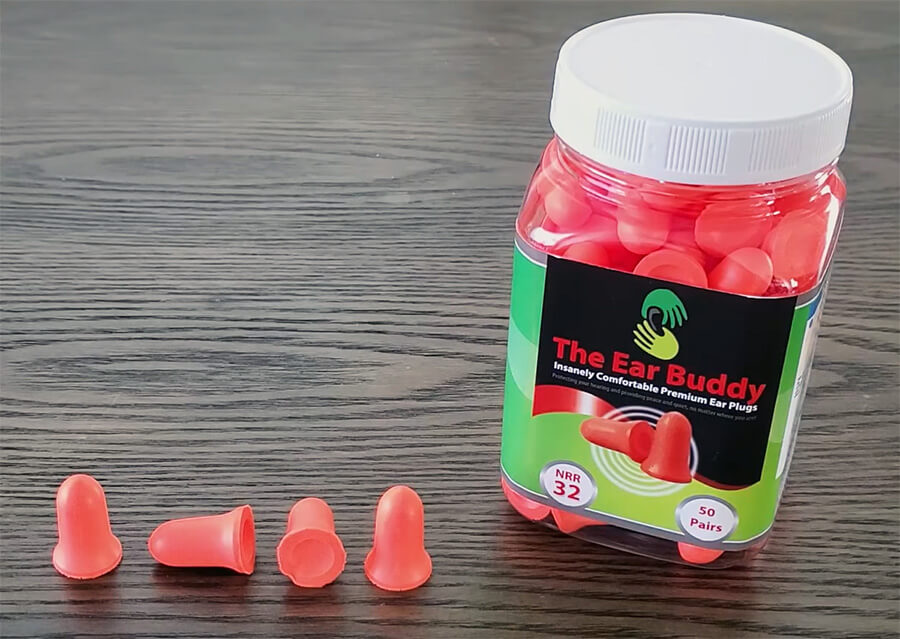
The Ear Buddy are good medium sized earplugs to use for sleep. I especially like their shape as the bell curve on the external end means they are easier to remove in the morning.
Grabbing the wide end to pull them out of your ears is slightly easier than the standard cone-shaped earplugs (note that it’s best to slowly twist foam earplugs when removing them, rather than pulling them out quickly in one motion).
They’re comfortable to wear in bed at night, and I like the foam because it doesn’t feel too dense. They have a good noise reduction rating of 32 dB, which means that, for me, they do a really good job of blocking out most noise at night.
This pot came with 50 pairs, and when you open it up you’ll find that, like some of the others that come in pots that I’ve looked at, they don’t come individually wrapped.
They were slightly more expensive than some of the other foam earplugs when I bought them, at 36 cents per pair. It was just under $18 for the pack of 50. I’m not sure why they are so expensive, but still, 36 cents per pair isn’t too bad.
On balance, I think these are good earplugs to try if you’ve got medium or large size ears. And potentially even if you’ve got smaller ears, but not too small. It might be worth having a go as you might find that they’ll do a really good job of blocking out noise for you.
The Ear Buddy
- Material: foam
- Size: medium
- Shape: bell
- Quantity: 50 pairs
- Individually wrapped: no
- NRR: 32 dB
- Price: 36 cents per pair
Hearoes Xtreme Protection + Hearoes Ultimate Softness
Small and medium foam earplugs with good noise reduction

Let’s take a look at two different sets of Heroes earplugs. We have the Xtreme Protection, which have a noise reduction rating of 33 dB, and the Ultimate Softness which have a noise reduction rating of 32 dB. So they’re quite similar where the official lab tests are concerned.
There’s a considerable difference in their size though. The Heroes Xtreme Protection are definitely bigger, so I recommend them for people who have larger ear canals. And the Ultimate Softness I think are on the smaller side, so they’re ones you could try if you’ve got smaller ear canals.
When it comes to comparing them with other earplugs, the Ultimate Softness look very similar to the Mack’s Ultrasoft. They are similar in size, both the length and diameter, and both have a beige colour.
However, when it comes to the finish, I think that the Mack’s Ultrasoft are smoother compared to the Ultimate Softness. If you look at the ends, it just doesn’t feel like the factory has finished them quite as nicely. So I would stick with the Mack’s Ultrasoft because of that main reason.
In this photo, you can see how the Hearoes Ultimate Softness (right) and Mack’s Ultra Soft (left) look similar:

As for the price, the Xtreme Protection were $8.83. That meant that there were 63 cents per pair. The Ultimate Softness were $7.17, and because there are more pairs in the pack, that means that they were 36 cents per pair. So again, they’re relatively expensive for foam earplugs – at least the Xtreme Protection. It’s worth shopping around to see if you can find them for a lower price.
So on balance, I would recommend trying the Xtreme Protection if you’ve got larger ear canals. The Ultimate Softness might be ones to try if they’re the only ones that you can find and you’ve got smaller ear canals. But again, considering they’re very similar to the Mack’s Ultrasoft, I would stick with the Mack’s personally.
Hearoes Xtreme Protection
- Material: foam
- Size: large
- Shape: cone
- Quantity: 14 pairs
- Individually wrapped: no
- NRR: 33 dB
- Price: 63 cents per pair
Hearoes Ultimate Softness
- Material: foam
- Size: small
- Shape: cone
- Quantity: 20 pairs
- Individually wrapped: no
- NRR: 32 dB
- Price: 36 cents per pair
3M 1100
Lowest price per pair. Good earplugs for the workplace, and maybe for sleeping with loud noise

Next up, we have the giant box of 3M 1100 earplugs. In the video, I roll one into a cone so you watch it expand while I’m talking to demonstrate what I mean about waiting for them to expand in your ears. It takes the whole segment for it to fully expand, which is longer than a minute (see it at 3:34 in the video).
The 3M 1100 are good earplugs for larger ear canals. And for me, even though I’ve got smaller ear canals, I believe these do a fantastic job of blocking out noise as well.
They’ve got an official noise reduction rating of 29 dB, which isn’t as much as some of the others that have 33 dB, for example. However, for me these do the best job of all the earplugs at blocking out noise.
Having said that, they’re not ones that I would use to sleep night after night, just because they’re a little bit too big and a little bit denser than a lot of the other earplugs that are made with a softer foam, especially the ones that have been made particularly for sleep.
But if you’ve got a serious noise problem outside, and you’ve got medium to large size ears, then these are ones that I would think about trying.
And if you’re checking out this review to help you choose some for your noisy workplace rather than sleep, then these would definitely be ones that I’d recommend. They are individually wrapped in plastic wrappers, which makes them suitable for multiple people to use.
I paid just over $22 dollars for the box of 200 pairs, which means they worked out 11 cents per pair. And that makes them the cheapest of all these earplugs, probably because I bought them in such a large quantity.
3M 1100
- Material: foam
- Size: medium/large
- Shape: cone
- Quantity: 200 pairs
- Individually wrapped: yes
- NRR: 29 dB
- Price: 11 cents per pair
Howard Leight Max Lite + Laser Lite
Medium and large foam earplugs with winged tips for easy removal
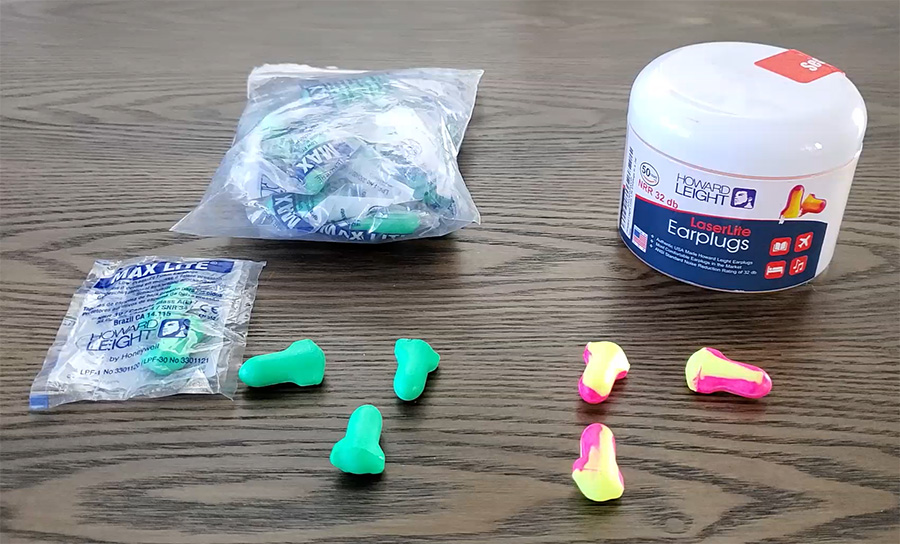
Let’s take a look at two more styles of earplugs made by Howard Leight: the Max Lite and the Laser Lite. The Laser Lite are a bit bigger, so I would describe them as large size. And I would say the Max Lite are medium size.
What I like about these ones are, well, if I’m honest the fact that they kind of look like little spaceships, which always entertains me!
Joking aside, what I like about these two is that they both reliably block out noise. The Howard Leight Laser Lite technically have a noise reduction rating of 32 dB. And the Max Leight a little bit less at 30 dB. But for me, they both work really well. So I do recommend trying them if you’ve got medium or large size ear canals.
It’s also interesting to note that the Max Lite are packed in individually wrapped bags. I think that’s perhaps because they were intended for the workplace. In contrast, the Laser Lite are all together in a pot of 50. So again, it depends on your opinion on how hygienic it is to be putting your hands in there and pulling earplugs out night after night, potentially leaving germs in there.
Personally, I don’t have a problem with them being loose in a pot. I quite like having a storage pot rather than being individually wrapped because with individually wrapped ones you’re throwing away plastic as well as the foam earplugs if you’re going to be using them in a disposable way. And since you can reuse the pot when it’s empty, my view is that it’s more environmentally friendly.
As for the price, there’s quite a big difference between these despite being made by the same company. The Laser Lite worked out at 56 cents per pair, as they were $13.99 for 25 pairs. The Max Lite were 26 cents per pair, which was 25 pairs for $6.39.
Perhaps with the Laser Lite you’re paying for the fact that they come in a tub to keep them in rather than just all wrapped in plastic. But I think you might be able to find these for different prices if you shop around.
On balance, I think that Howard Leight earplugs generally are very good, and are worth trying if you’ve got medium or large size ears. I also like the fact that Howard Leight have obviously catered to people with smaller, medium, and larger size ears.
Howard Leight Laser Lite
- Material: foam
- Size: large
- Shape: winged end
- Quantity: 25 pairs
- Individually wrapped: no
- NRR: 32 dB
- Price: 56 cents per pair
Howard Leight Max Lite
- Material: foam
- Size: medium
- Shape: winged end
- Quantity: 25 pairs
- Individually wrapped: yes
- NRR: 30 dB
- Price: 26 cents per pair
Moldex Soft Foam + Spark Plugs
Long earplugs with good noise reduction for people with deeper ear canals
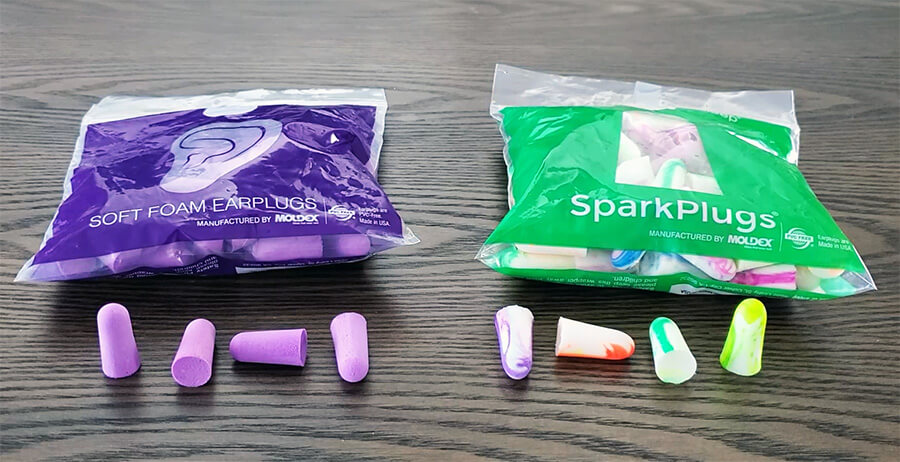
Next up, I’m going to talk about earplugs which I think will work well for people with deeper ear canals – those who’ve lost earplugs deep inside their ears and had to get them out with tweezers in the morning, which is never a nice experience.
For me, Moldex generally manufacture the best earplugs if you’ve got deeper ear canals. They just tend to be longer than most other earplugs.
It’s worth noting that Moldex earplugs are sometimes sold under different names online and in stores, as they have different distributors. I’ll be discussing two more in the Flents section (coming up), so you’ll find that there are four different sets of Moldex that I cover, all with different names.
For now, let’s focus on the Moldex Soft Foam earplugs and the Spark Plugs. The Spark Plugs were the first ones I ever tried by Moldex when an electrician friend of mine threw me a set and said “try these bad boys, these are the best earplugs you’ll ever try.” And they were really good.
Moldex earplugs generally have a noise reduction rating of 33 dB (all four that I’ll be looking at in this review do).
What I like about these as well is, well, not just the bright colors – Moldex are good for making bright colors! But I like the fact they’re made with a decent soft foam. They’re comfortable earplugs to wear while sleeping, and they are very long.
For me personally, they’re potentially a tad too long because I’m a side sleeper. But if you’re not a side sleeper, you sleep on your back, or you’ve got medium or large size ear canals, and particularly deep ear canals, I think both of these earplugs are a viable option that you might like.
When I compare them to the small Howard Leight, for example, you can see that they’re a lot longer. And even if I compare them to the Mack’s Ultra Soft, you can see that they’re quite a bit longer than those as well (I demonstrate this at 16.24 in the video).
In the photo below, you can see the Howard Leight small on the left, the Moldex Soft Foam in the middle, and the Moldex Spark Plugs on the right.

The prices were pretty good. They were $8.99 for the Soft Foam when I bought them for a pack of 40. And $12.99 for the Spark Plugs for a pack of 50. That works out at 22 cents per pair for the Soft Foam and 26 cents per pair for the Spark Plugs at the time that I bought them.
So overall, I think these are good ones to try if you’ve got deeper ear canals, particularly people with medium and large size ear canals. If you have deeper ear canals that are very narrow, however, you might find them a touch uncomfortable when fully expanded.
Moldex Soft Foam
- Material: foam
- Size: long (medium-large diameter)
- Shape: cone
- Quantity: 40 pairs
- Individually wrapped: no
- NRR: 33 dB
- Price: 22 cents per pair
Moldex Spark Plugs
- Material: foam
- Size: long (medium-large diameter)
- Shape: cone
- Quantity: 50 pairs
- Individually wrapped: no
- NRR: 33 dB
- Price: 26 cents per pair
Flents Quiet Time +Quiet Contour
Good noise reduction with unique contoured bell shape for larger ear canals
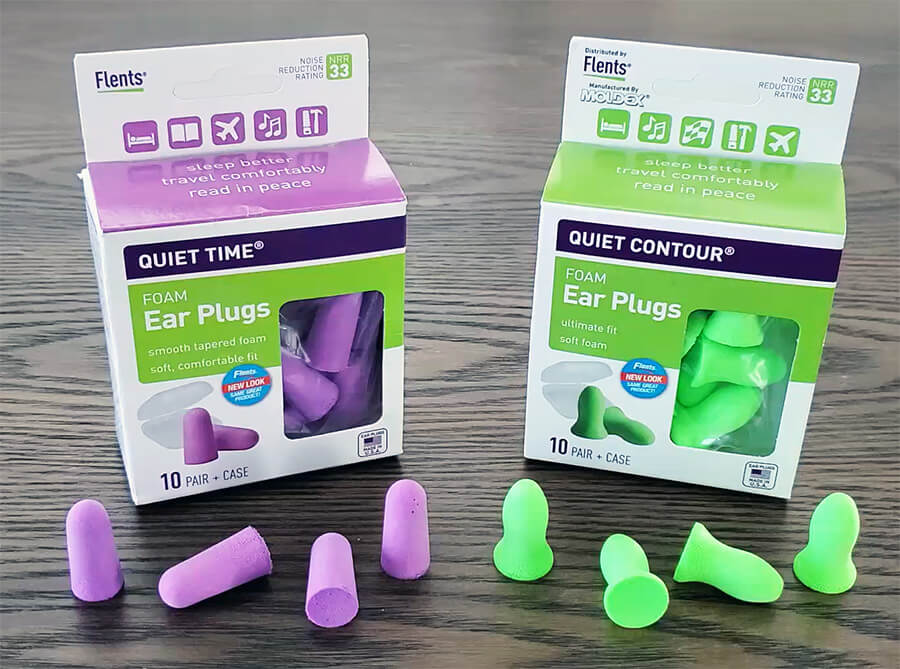
Next up, we have two sets of earplugs that are distributed by Flents and manufactured by Moldex.
Like the two sets of Moldex I looked at in the previous section, these both have a noise reduction rating of 33 dB as well, which is considered to be a high rating. It means that they have good potential to block out a considerable amount of noise for you.
I think the Quiet Contour are probably best for people with larger ear canals, and they have a very unique design. They are the only ones in this comparison that have a curved bell shape, so they could be interesting ones to try if you’ve got larger ear canals.
Whether they work for you or not is hard to predict without checking the exact shape of your ear canal in advance, which very few people realistically do. So it’s a case of trial and error if you feel like testing a different shape from the cookie-cutter cone or bell shape that most have.
In contrast to those, I would say the Quiet Time are probably better for people with medium ear canals. Really though, we’re talking about quite small differences so you might also like to try them if you’ve got larger ear canals.
One thing that’s worth pointing out is that they are very similar – I’d go so far as to say identical – to the Moldex Soft Foam earplugs. When I hold them up side by side, it’s clear that they are so similar (17:40 in the video). And that just shows that Moldex earplugs might be distributed by different sellers or under different brand names, but they are all Moldex at the end of the day.
In terms of the price, they varied quite a lot when I bought them. And that’s because I got the Quiet Contour on offer for $2.98 for 16 pairs, which meant that they were 30 cents per pair.
However, the Quiet Time were $7.77 for 10 pairs, which meant that they were 78 cents per pair. And that means that they’re one of the most expensive foam earplugs that I’ve tried.
So it illustrates how it’s worth shopping around because the Moldex Soft Foam worked out much cheaper than the Flents Quiet Time despite being basically the same earplug in my view.
Update: since recording the video and writing this, I’ve checked back on the prices. The Quiet Contour are still fairly cheap. Interestingly, it seems Flents are selling some Quiet Time under the new name Protechs Quiet Time now, and have a tub of 50 for a better price.
Flents Quiet Time
- Material: foam
- Size: medium
- Shape: cone
- Quantity: 10 pairs
- Individually wrapped: no
- NRR: 33 dB
- Price: 78 cents per pair
Flents Quiet Contour
- Material: foam
- Size: large
- Shape: curved bell
- Quantity: 16 pairs
- Individually wrapped: no
- NRR: 33 dB
- Price: 30 cents per pair
Quies (wax)
Wax earplugs for those who don’t like the feel of foam expanding in the ear

If you prefer wax earplugs instead of foam, the Quies are probably the best ones that I’ve tried even though there are several brands that make similar wax earplugs. There’s not really that much difference between them when you inspect them closely.
The Quies usually come in a case of eight pairs, but I bought two cases for the price of $12.60 at the time, so they were 79 cents per pair.
The lab tested noise reduction rating is 27 dB, which is much less than all of the foam earplugs I’ve covered above. It’s normal for wax to have a lower official rating than most good foam earplugs, so this isn’t an issue that’s unique to Quies.
Out of the packet, they come with cotton wool wrapped around them, which you’re supposed to remove first. You then roll the exposed wax ball between your fingers, maintaining a ball shape at first, and then flatten it over your ear opening to get a good seal, rather than inserting it all the way into your ear canal.
It’s important to understant that you’re not meant to roll wax earplugs into a cone; you’re not supposed to do what you would with foam earplugs and stick them in.
But it does mean that if you’ve got larger ear canals, then perhaps this small ball of wax isn’t going to be enough to really cover them without accidentally going too far in.
And that’s something that I’ve found myself when I’ve used wax earplugs, and also the smaller silicone ones. Even though I try to mold them over my ear canal opening and try my best to get a seal, they can still end up going in quite far, and then they’re quite difficult to remove.
And I think because these warm up with your body heat as well, it can affect how far they go in. So I’m not a massive fan of wax because they feel sticky and they go too deep into my ear even though I try not to let them go in. That combined with the lower noise reduction rating means foam is my go-to earplug material at night.
Despite my reservations about wax, if you struggle with foam earplugs then I would still recommend trying wax and/or silicone because they are probably the best alternative.
Wax might not work particularly well for me, but I know many people prefer it to foam – side sleepers especially. So if you don’t like the feeling of foam expanding in your ears, and think wax will be more suitable, the natural wax of Quies is one to try.
Quies
- Material: natural wax
- Size: any
- Shape: mold over your ear canal opening
- Quantity: 2 cases of 8 pairs (16 pairs)
- Individually wrapped: no
- NRR: 27 dB
- Price: 79 cents per pair
Mack’s Pillow Soft (silicone)
Silicone to cover the ear canal rather than going deep inside

Another alternative to foam earplugs is silicone, such as the Mack’s Pillow Soft silicone putty earplugs. If I was going to use silicone, these would probably be the ones I would use because I’ve had the most success with these compared to other ones.
However, as with wax, there aren’t actually that many brands of silicone earplugs to choose from, so it might be worth trying more than one brand to find the one that works best for you.
With these, it’s also important to realise that they aren’t supposed to go deep into your ear canal. You just take the ball that they come out in and flatten it over your ear canal to get an airtight seal, at least in theory.
You’ll see in the instructions on the packet that they warn you not to shape it into a cone, but place it over your ear opening and flatten it to form an airtight seal.
They do warm up as well, which is one of the properties of silicone earplugs in general that I have an issue with. When they warm up because of your body heat, I find they become quite sticky. And once they stick to your skin, removing them in the morning feels kind of icky.
Another criticism I have is of the noise reduction. These have an average expected noise reduction rating of 22 dB according to lab tests, and you can really feel the difference as well. When you use good foam earplugs and compare them with these, they just don’t block out nearly as much noise as the foam do.
However, if you don’t have that much noise to contend with and you don’t like foam earplugs, they are a reasonable alternative.
The price was higher than some of the other earplugs as well. They worked out at $1.08 per pair, which was for a pack of 12 pairs at $12.99.
Overall, I’d say give silicone and wax a go if you don’t get on well with foam earplugs. Just keep in mind that if you want the best noise reduction possible because you sleep in a particularly noisy bedroom, I wouldn’t have high expectations of the Mack’s Pillow Soft, or any other silicone earplugs currently available.
Note: I didn’t mention it in the video, but the Mack’s Pillow Soft balls of silicone are considerably larger than the Quies wax. So if you’re deciding between the two, and feel you need a larger quantity of material to cover your ear opening, the Mack’s might be a more suitable option for you.
Mack’s Pillow Soft
- Material: silicone
- Size: any
- Shape: mold over your ear canal opening
- Quantity: 12 pairs
- Individually wrapped: no
- NRR: 22 dB
- Price: $1.08 per pair
Brison (soft plastic)
Flanged tips for different ear canals sizes, but tricky to remove in the morning

Finally, we come to the soft plastic style of earplugs. I’ve seen a growing number of brands that look very similar to these sold online these days.
They always say that it’s good that they have the layers of ribs, or flanges, which means that they can fit different ear canals. And while that may be true, for me there’s one glaringly obvious issue with these: getting them out again in the morning is notoriously tricky.
They have a short, narrow cylinder on the end which you’re supposed to be able to grab with your fingers. Maybe people with tiny fingers or long fingernails might be able to.
With my big fingers though, it always means digging tweezers into my ears in the morning, not even being able to see what I’m doing with the tweezers, and trying to fish them out. And I find that’s very uncomfortable and surprisingly difficult to do, so for that reason I don’t recommend using these earplugs.
Also, when it comes to the noise reduction you’re not going to get nearly as much as you would do with foam, and potentially not even as much as with the wax either. These don’t say how much the noise reduction is on the box, but I suspect they’re somewhere between 20 dB and 25 dB. So they’re not even particularly good at blocking noise.
So overall, I would personally recommend avoiding this type of earplug just because of the risk of getting them stuck in your ears and finding it difficult to remove them in the morning.
Update: I forgot to mention the price in the video. I paid $15.99 for one pair, which isn’t as outrageous as it sounds as they are reusable. Since making the video it appears they no longer sell just this pair, but have combined it in a multipack with a different style.
Brison
- Material: soft plastic (they call it liquid silicone)
- Size: small
- Shape: flanged cone
- Quantity: 1
- Individually wrapped: yes
- NRR: Unknown
- Price: $15.99 for one reusable pair
Currently unavailable

